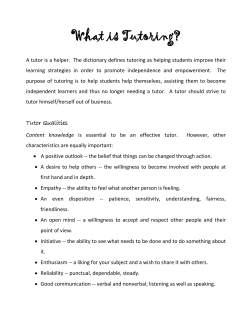
e-tutor - DL@WEB
DL@WeB- WP3 Meeting Vrnjačka Banja, 22-23 januar 2013 General recommendations for organizing user support in DL study programs Valeri Caraguel University Paul Cézanne Milena Stanković Univerzitet u Nišu, Elektronski fakultet DL@WeB - WP3 Meeting, Vrnjačka Banja, 22-23 januar 2013. Who is the e-tutor? • E-learning should not mean learning alone. Some activities can be designed to be carried out on one’s own. Guidance is needed. • Various names: mentor, guide, instructor, facilitator, coach, moderator, and leader. • It seems that e-tutor can cover all of these meanings: – She/he is the person guiding the student all along her/his learning process; – She/he is also the closest person to the student; – Besides being an expert, the tutor is a professional in accompaniment and guidance. DL@WeB - WP3 Meeting, Vrnjačka Banja, 22-23 januar 2013. Why would you organize e-tutoring? • Both in blended-learning and in e-learning programs, e-tutoring is necessary to prevent lack of motivation, feeling of isolation and desertion. • E-tutoring is team work. It needs a rigorous organization, listening competencies, empathy, reactivity and proactivity capabilities. • Flexibility is also needed to meet the students’ constraints, level of familiarity with ICT and distance learning. • Individualization of interventions is one of the most important key factors of success. DL@WeB - WP3 Meeting, Vrnjačka Banja, 22-23 januar 2013. Towards the implementation of a tutoring system • • • • • • Analyzing learners’ needs in terms of help Define fields of support in learning to investigate Identify the roles and functions of the various tutors Design and quantify the tutoring interventions Choose the tools to communicate Write a tutoring chart (relating the rights and the duties of both students and tutors in the tutoring relationship) • Train the tutors and implement communities of practice • Create tools to follow the tutoring relationship. DL@WeB - WP3 Meeting, Vrnjačka Banja, 22-23 januar 2013. TUTORING ENGINEERING ANALYSIS / DEFINITION DESIGN DISSEMINATION Analyzing students’ guidance needs Designing and quantifying the tutoring interventions Training e-tutors and implementing communities of practice Investigating domain of learning support Identifying roles and functions of the different e-tutors Choosing the communication tools Writing the tutoring chart Creating tools and dashboard to coordinate the tutoring system Defining the economic model for the tutoring system DELIVERY DELIVERY DELIVERY Tutoring System Tutoring Scenario Dissemination Plan DL@WeB - WP3 Meeting, Vrnjačka Banja, 22-23 januar 2013. The objective of a tutoring system The first objective of a tutoring system is to identify the different actors and their scope of actions. – The course tutor: interface between the learners and the learning resources, – The coordinator: mediator between the e-tutors, the group of learners and the institution, – The administrative tutor: in charge of the student along her/his “administrative life”, – The technical tutor: in charge of the appropriation of technology by learners. DL@WeB - WP3 Meeting, Vrnjačka Banja, 22-23 januar 2013. E-tutor is in the center of the e-learning system Institution Structure Contents (of the programme) e-tutor Group Student DL@WeB - WP3 Meeting, Vrnjačka Banja, 22-23 januar 2013. Different modalities of intervention Institution Structure (of the programme) Contents programme) e-tutor Personne tutrice Meetings for collective sessions Individual e-tutoring Collective e-tutoring • Represents the institution in front of the students (belongs to a community, control and assessment) • The structure enables him to : • Implement the learning strategy • Give stability and continuity in the learning process Group • Meet and guide the student • Guide the student through his/her learning process • Support to reveal his/her abilities, potentialities and preferences • Help to change Peer to peer e-tutoring DL@WeB - WP3 Meeting, Vrnjačka Banja, 22-23 januar 2013. Student Working in a team Ideally, we should find: • a course tutor : can be author of the contents or just a specialist in the domain • a “project” tutor: to guide the students through their project, trainingperiod, thesis (depending on the curriculum) • a coordinator (responsible for the curriculum): to coordinate all the different actions of the e-tutoring system • a technical tutor: to facilitate the use of the tools and design tutorials • an administrative tutor: for all the administrative processes (appliance, finance, certificate, organization of the exams, time-table,…) • a peer-tutor: a former student of a curriculum who helps others. The composition of the team will depend on the number of courses, the policies of the institution, and will be reduced taking into account the different parameters. DL@WeB - WP3 Meeting, Vrnjačka Banja, 22-23 januar 2013. Roles and competencies of e-tutors Four main roles have been identified for the etutor: • a pedagogical role with two levels – cognitive and metacognitive, • a socio-emotional role, • a technological role, • an organizational (or managerial) role. DL@WeB - WP3 Meeting, Vrnjačka Banja, 22-23 januar 2013. Considering a research synthesis on TAM model researches (Ayadi-Kammoun, 2009) showing seven determinants of the use of an e-learning system by students, we are able to spot these four roles: Determinants of use Student’s motivation Availability of the technological device Use of technology Time Interaction with others Atractivity of the course Organization of students’ accompaniment Tutor’s skills Tutor’s role Reactivity, proactivity Socio-emotional Reliability Technological Appropriation Technological Individual organization Organizational Different types of e-tutoring Organizational Mediatisation and interactivity Design and implementation of etutoring system DL@WeB - WP3 Meeting, Vrnjačka Banja, 22-23 januar 2013. Pedagogical and technological Pedagogical (metacognitive aspects) and organizational Competencies Roles Pedagogical Skills - Cognitive level = expert of the domain - - Meta-cognitive level = cognitive strategies Support Make technology transparent, clear - To know the learning processes - Concerning activities - Be dynamic, reactive, proactive - Concerning learning engineering and management of the project - To be able to implement the logistic backup To be able to monitor the activities and follow the group of students To have relational skills Socioemotional Technological - Organization al (or managerial) To be able to transfer knowledge To be able to construct an individual training curriculum To be able to tell if a goal has been reached - Empathy, availability Proactivity Master technology Make appropriate choices of tools Create tutorials and handbooks DL@WeB - WP3 Meeting, Vrnjačka Banja, 22-23 januar 2013. What does it depend on? Institutional choices • • E-tutoring depends on the environment and the political choices of the e-learning curriculum. If you have no budget for e-tutoring, you need to re-engineer your contents to enable students to learn completely by themselves. Usually, an e-tutor should be in charge of around 30 learners online. The number of learners to look after will have an influence on the level of quality of your etutoring. This is typically an institutional choice. For example: • Open University UK = 1 tutor for 25 students • Chinese Televisual University = 1 tutor for 70 students • Indira Ghandi National Open University = 1 tutor for several hundred students Tools and e-learning platform • The tools and the platform supporting e-learning device are very important. They will design the user DL support. DL@WeB - WP3 Meeting, Vrnjačka Banja, 22-23 januar 2013. What does it depend on? The level of storyboarding of the courses • The more precise your storyboard is, the less e-tutoring you need. The learning models implemented • The level and the style of guidance will depend on the learning models implemented. In the array above (table 1), you have an overview of implementation depending on the knowledge you want to transfer or the construction of knowledge you want to create. • In a behaviorist perspective, you will teach course in which automatism will be learnt, or a succession of simple actions. Behaviorism does not facilitate critical thoughts, or develop comprehension. • Constructivism will be used for problem solving, simulation. Here knowledge is constructed in doing: “Learning by doing” perspective. • Social learning (bandura) and situated learning (Lave and Wenger) are two perspectives dealing with social interactions and interpersonal relationships. Nowadays, they will typically be supported by social networks tools. DL@WeB - WP3 Meeting, Vrnjačka Banja, 22-23 januar 2013. Perspective E-learning is … - Implementation Instrumental, behaviorist and positivist Relational, connectionist and constructivist Collective and socio-constructivist … a transmission …an exchange … a negotiation of sense It is considered that we can transfer knowledge “Just-in-time pedagogy” - Standardization of contents Norms of interoperability Experience is a source of knowledge “Help yourself pedagogy” - - Autonomy, individualization, tutoring - All communication is a negotiation. Social interaction is the source of knowledge “Collective reuse” - Collaborative environment - Social networks Modelling of pedagogical activities Table 1: E-learning in an epistemological perspective. (Caraguel 2012, inspired by Fallery, 2007) DL@WeB - WP3 Meeting, Vrnjačka Banja, 22-23 januar 2013. Synthesis • E-tutoring is not an element to elaborate after the whole e-learning device has been implemented. • It must be part of the initial conceptualization on the device. Political choices, as well as pedagogical and technological ones are, all together, the elements that will permit to follow and support the students in their e-studies. • The implementation of the e-tutoring system is one important quality factor for e-learning programs. DL@WeB - WP3 Meeting, Vrnjačka Banja, 22-23 januar 2013. To go further: • Salmon, G. (2000), E-Moderating. The Key to Teaching and Learning Online, Kogan Page, London. • Salmon, G. (2003), E-tivities. The Key to Active Online Learning, RoutledgeFalmer, London. • Smith, P., Dillon, C. (1999), “Comparing distance learning and classroom learning: Conceptual considerations”, The American Journal of Distance Education, Volume 13, N° 2 (1999). • Sulčič, V., Sulčič, A. (2007), « Can Online Tutors Improve the Quality of E-Learning? », Informing Science and Information Technology, Volume 4, 2007. • Webster, J., Hackley, P. (1997), “Teaching Effectiveness in Technology-Mediated Distance Learning “, The Academy of Management Journal, Vol. 40, No. 6 (Dec., 1997), pp. 1282-1309. DL@WeB - WP3 Meeting, Vrnjačka Banja, 22-23 januar 2013.
© Copyright 2025











